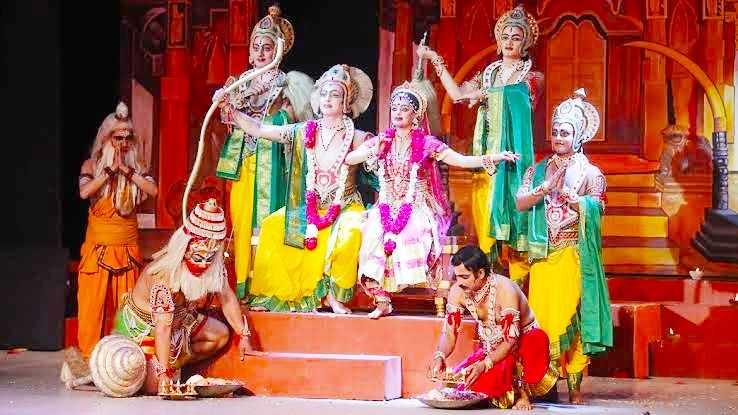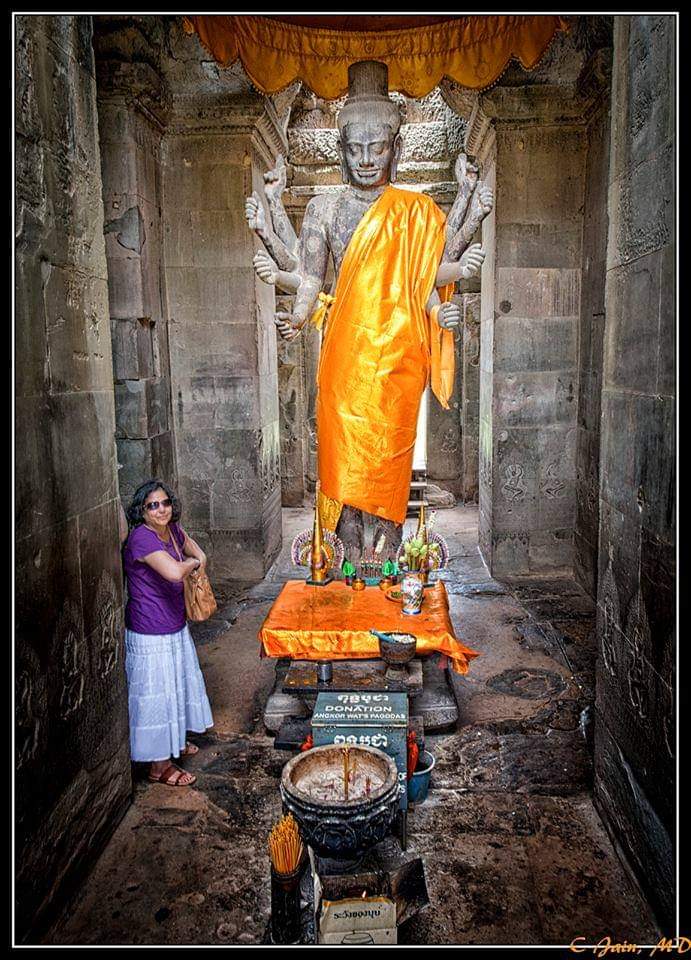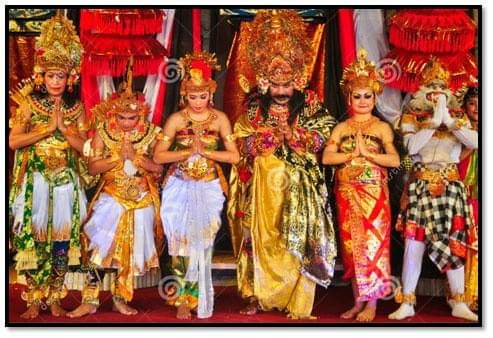Ramlila: In Shri Rama’s Universe
Ramlila: In Shri Rama’s Universe
🕉️ Jai Shri Ram 🚩💓💐🙏,
This one perhaps does not require an introduction. Ramlila is the story of Prince Ram of Ayodhya enacted in a theatrical form.Ramlila is a dramatic folk re-enactment of the life of Lord Ram, ending up in ten-day battle between Shri Ram and Ravan, as described in the Hindu religious epic, the Ramayana. The central figure of the Ramayana, ‘Rama’ is the 7th incarnation of Bhagwan Vishnu and therefore, the Ramayana is based on the life, times and values of Lord Rama. The very story of Ramayana injects ethics to the Indian mainstream.Shri Rama is called the Maryada Purushottam or 'The best among the dignified'. The story of Shri Rama and his comrades is so popular in India that it has actually amalgamated the psyche of the Indian mainstream irrespective of their religion.The tradition of Ramlila play that originates from the Indian subcontinent, is staged annually often over ten or more successive nights, during the auspicious period of 'Sharad Navratras', which marks the commencement of the autumn festive period, starting with the Dussehra festival. Most Ramlilas are based on the Awadhi version of Ramayan called the Ramcharitmanas composed by Tulsidas.
SHRI Rama occupies a very unique space in the psyche of Hindus. He is considered as the personification of Dharma (righteousness) and an ideal man. The story of his life (i.e. Ramayana) have been spoken, song, dramatized and celebrated in various other ways for many centuries. Historically, the enactment of Ramlila, as witnessed today in India, can be traced back to the 16th century, when Tulasidas composed Ramacharitmanas in Awadhi language, though there are evidences for the presence of some form of staged performances of Ramayana even before that time.
Famous Ramlila shows in India: Govt. of India and IGNCA produced a two-hour documentary, titled "Ramlila - The traditional performance of Ramayana" for UNESCO, on 'Ramnagar Ramlila', and Ramlila traditions of Avadh, Braj and Madhubani, and that of Ayodhya, which assimilates elements of all three. Ramlila’s of these places are the most famous in India. Another unique Ramlila of India, is being staged since 1972, at Bakshi Ka Talab, about 20 km from Lucknow, where lead characters like Rama, Lakshman and Hanuman are played by Muslim youths, a clear departure in a region known for communal flare-ups. This four-day Ram Lila of Lucknow has also been adapted into a Radio play, 'Us Gaon ki Ram Lila', by Lucknow All India Radio, which won the Communal Harmony Award in 2000.
Although, the enactment of Ramlila is mostly predominant within North India and performances in Ayodhya, Benares, Vrindavan, Almora, and Sattna are especially famous. But, Ramlila enactment is not limited to India. Just as Hindus have spread across the world over the last 2 centuries, the celebration of Ramlila has also spread along with them. Even, UNESCO proclaimed the tradition of Ramlila a Masterpiece of the Oral and Intangible Heritage of Humanity in 2005. Ramlila has received considerable global attention, especially due to its diverse representation throughout the globe, especially amongst the Indian diaspora community, and regions where Hinduism has spread over the centuries, like Africa and several South East Asian countries. People of various communities have been coming together to celebrate each other’s festivals. In fact, there has been a rich tradition of performing the Ramlila or a dramatic representation of scenes from the Ramayana even in some predominantly Muslim countries like Indonesia, as well as in Buddhist countries.Islam is our religion, but Ramayan is our culture," goes the popular slogan in Indonesia. And adhering to this slogan, in letter and spirit, is not only Indonesia but several other Southeast Asian countries like Cambodia, Thailand and laos etc that organises Ramlila’s in their respective cities with pomp and Gaiety. Ram Leela is also performed in Caribbean countries like Trunidad and Tobago, besides some other nations.Officials of Ayodhya Research Institute, Faizabad, who have documented Ramlilas held in Southeast Asia and conducted various exchange programmes, has said that like India, Ramlila in these country also begins on Navratri and goes on till Diwali. However, the Ramlila performed in these countries is slightly different from those in North India.
🕉️ Bhagwan Shri Ram & Vedic History of the World 🚩💓💐🙏
Here is a list of Countries where Ramlila performances are staged:
1. CAMBODIA- The Kingdom of Cambodia located in Southeast Asia, was once part of the mighty Hindu Khmer kingdom that had ruled for 600 years. Though, it is now primarily a Buddhist country, the Hindu influences are still visible in the country. Cambodia has its own version of Ramayana called ‘Reamker’, wherein Lord Rama is known as ‘Preah Ream’, Sita as ‘Neang Seda’, and Lakshman as ‘Preah Leak’. Reamker is the most popular Khmer literature and its influence extends to art, dance, and theater. Unlike the Ramlila performed in Trinidad and other Caribbean countries where the story is based on Tulasidas’s Ramacharitmanas, the Cambodian Ramlila is based on Reamker, which is again based on Valmiki Ramayana.
1. CAMBODIA- The Kingdom of Cambodia located in Southeast Asia, was once part of the mighty Hindu Khmer kingdom that had ruled for 600 years. Though, it is now primarily a Buddhist country, the Hindu influences are still visible in the country. Cambodia has its own version of Ramayana called ‘Reamker’, wherein Lord Rama is known as ‘Preah Ream’, Sita as ‘Neang Seda’, and Lakshman as ‘Preah Leak’. Reamker is the most popular Khmer literature and its influence extends to art, dance, and theater. Unlike the Ramlila performed in Trinidad and other Caribbean countries where the story is based on Tulasidas’s Ramacharitmanas, the Cambodian Ramlila is based on Reamker, which is again based on Valmiki Ramayana.
2. MAURITIUS- Republic of Mauritius is an island nation in the Indian Ocean off the southeast coast of Africa. It is a multi-ethnic society with Hinduism as the largest religion practiced by around 48.5% of the total population. Mauritius has a very vibrant and long tradition of Ramlila performance. It is also famous for its Ramayana singing on Jhal and Dholak. The Mauritian Ministry of Arts and Culture along with Mauritius Sanatan Dharma Temples Federation support and encourage Ramlila tradition. Mauritius also hosted the International Ramayana Conference.
4. SURINAME- The Republic of Suriname is an independent country located northeastern coast of South America and share borders with French Guiana, Guyana, and Brazil. Hindus are second largest religious group in Suriname and comprise around 22.3% of the total population. In Suriname, like in Trinidad & Taboga, Ramlila was introduced by the Indian immigrants around 150 years ago. In February 2015, it was reported that as part of India’s engagement with Indian diaspora in Suriname, Indian group of Ramila will perform in Suriname and Suriname group will perform in India.
5. TRINIDAD&TOBAGO- The Republic of Trinidad and Tobago consists of two islands and is located just off the northeastern coast of Venezuela in the South American continent. Ramlila entered into the twin-island country when indentured immigrants were brought into the country from India 1845. The earliest record of Ramlila celebration in Trinidad goes back to 1881 in Dow Village. Recently, in 2012, ‘The National Ramlila Council of Trinidad and Tobago’ (NRCTT) was made into the main representative body for Ramlila in the twin-island country, through an act of Parliament.
6. THAILAND- The Kingdom of Thailand, which was formerly known as Siam, is another country located in Southeast Asia. Thailand’s national epic is ‘Ramakien’, which is a version of Ramayana adopted from Valmiki, but has an influence of Indian vernacular versions as well. Ramakein has been adopted into widely adopted into art and theater. Thus, Thailand has a rich culture of Ramlila of its own.
7. LAOS- Laos is another country in Southeast Asia, where one can witness thriving Ramlila tradition. Though, it is a Buddhist country, Ramayana is quite popular and central to Laos’ culture and tradition. The Laos version of Valmiki Ramayana is called as ‘Phra Lak Phra Ram’,named after Lakshmana and Rama, and is the national epic of the country. Lao legends attribute the introduction of the epic from Angkor. Phra Lak Phra Ram plays a central role in song, dance, painting, sculpture, and theater.
8. INDONESIA- Though Indonesia is a Muslim country, Ramayana runs through the veins of Indonesians. A popular adage in Indonesia goes: ‘“Islam is our religion. Ramayana is our culture.’ Indonesians follow an old Javanese version of Ramayana written in around 9th century called ‘Kakawin Ramayan’. Ramayana plays a central role in Indonesian culture and expressions of art- painting, music, dance, and theater. It has a lively and rich tradition of Ramlila.
9. NETHERLANDS- The Kingdom of Netherlands is a sovereign country in the Western Europe. The country has more than 100,000 adherents of Hinduism, mostly Indo-Surinamese immigrants who emigrated there from Suriname in 1960’s. These Hindus in the Netherlands have the tradition of Ramlila alive and thriving. The Ramlila performed in Netherlands is usually based on Ramacharitmanas and is usually staged in Hindi or its dialects. In 2015, a Dutch version of Ramlila was also staged.
10. MYANMAR- The Southeast Asian nation of the Republic of the Union of Myanmar has a rich tradition of Ramayana. Myanmar’s unofficial national epic called ‘Yama Zatdaw’ is the Myanmar version of Ramayana. Zatdaw literally means ‘acted play’ and Yama refers to Rama. Thus, Yama Zatdaw is the dramatized play of Ramayana. The oral tradition of Ramayana is believed to have been introduced into Myanmar during the reign of King Anawratha, the father of Burmese nation, in the 11th century CE. The performance of the Ramayana play in the Royal courts can be traced to King Bodawpaya who ruled towards the end of the 18th century and early 19th century. Yama Zatdaw plays a very important role in Burmese arts, literature, culture, and tradition.
Ramayana in Malaysia. Hikayat Seri Rama is the Malay version of the Hindu epic 'Ramayana', The main story of Hikayat Seri Rama remains the same as the original Sanskrit version, but some aspects of it were slightly modified to a local context such as the spelling and pronunciation of names.
Shri Rama in Egypt :
Shri Rama in Ancient Hittie & Mittani Empires of ancient Iraq , Syria & Turkey regions
Shri Rama in Europe
Shri Rama in Russia
Shri Rama in Ancient South America
🕉️ Jai Shri Ram 💓🚩💐🌹🙏
Hara hara Mahadev🌹🌷🕉⛳🙏
Santoshkumar B Pandey at 8.30am
Santoshkumar B Pandey at 8.30am










































Comments
Post a Comment